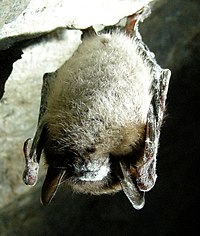
Photo from wikipedia
Abstract Mitigation of emerging infectious diseases that threaten global biodiversity requires an understanding of critical host and pathogen responses to infection. For multihost pathogens where pathogen virulence or host susceptibility… Click to show full abstract
Abstract Mitigation of emerging infectious diseases that threaten global biodiversity requires an understanding of critical host and pathogen responses to infection. For multihost pathogens where pathogen virulence or host susceptibility is variable, host–pathogen interactions in tolerant species may identify potential avenues for adaptive evolution in recently exposed, susceptible hosts. For example, the fungus Pseudogymnoascus destructans causes white‐nose syndrome (WNS) in hibernating bats and is responsible for catastrophic declines in some species in North America, where it was recently introduced. Bats in Europe and Asia, where the pathogen is endemic, are only mildly affected. Different environmental conditions among Nearctic and Palearctic hibernacula have been proposed as an explanation for variable disease outcomes, but this hypothesis has not been experimentally tested. We report the first controlled, experimental investigation of response to P. destructans in a tolerant, European species of bat (the greater mouse‐eared bat, Myotis myotis). We compared body condition, disease outcomes and gene expression in control (sham‐exposed) and exposed M. myotis that hibernated under controlled environmental conditions following treatment. Tolerant M. myotis experienced extremely limited fungal growth and did not exhibit symptoms of WNS. However, we detected no differential expression of genes associated with immune response in exposed bats, indicating that immune response does not drive tolerance of P. destructans in late hibernation. Variable responses to P. destructans among bat species cannot be attributed solely to environmental or ecological factors. Instead, our results implicate coevolution with the pathogen, and highlight the dynamic nature of the “white‐nose syndrome transcriptome.” Interspecific variation in response to exposure by the host (and possibly pathogen) emphasizes the importance of context in studies of the bat‐WNS system, and robust characterization of genetic responses to exposure in various hosts and the pathogen should precede any attempts to use particular bat species as generalizable “model hosts.”
Journal Title: Ecology and Evolution
Year Published: 2017
Link to full text (if available)
Share on Social Media: Sign Up to like & get
recommendations!